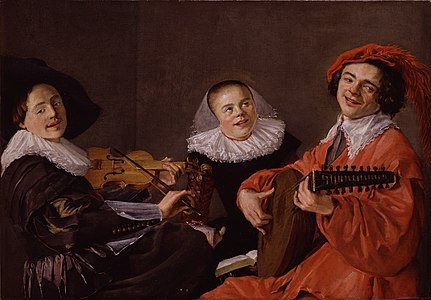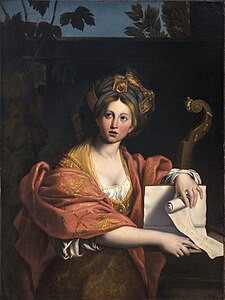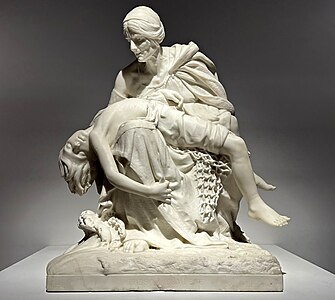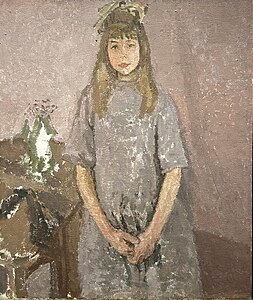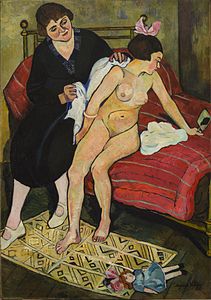
Magdalena Carmen Frida Kahlo y Calderón was a Mexican painter known for her many portraits, self-portraits, and works inspired by the nature and artifacts of Mexico. Inspired by the country's popular culture, she employed a naïve folk art style to explore questions of identity, postcolonialism, gender, class, and race in Mexican society. Her paintings often had strong autobiographical elements and mixed realism with fantasy. In addition to belonging to the post-revolutionary Mexicayotl movement, which sought to define a Mexican identity, Kahlo has been described as a surrealist or magical realist. She is also known for painting about her experience of chronic pain.

Guerrilla Girls is an anonymous group of feminist, female artists devoted to fighting sexism and racism within the art world. The group formed in New York City in 1985, born out of a picket against the Museum of Modern Art the previous year. The core of the group's work is bringing gender and racial inequality into focus within the greater arts community and society at large. The Guerrilla Girls employ culture jamming in the form of posters, books, billboards, lectures, interviews, public appearances and internet interventions to expose disparities, discrimination, and corruption. They also often use humor in their work to make their serious messages engaging. The Guerrilla Girls are known for their "guerrilla" tactics, hence their name, such as hanging up posters or staging surprise exhibitions. To remain anonymous, members don gorilla masks. To permit individual identities in interviews, they use pseudonyms that refer to deceased female artists such as Frida Kahlo, Käthe Kollwitz, and Alice Neel, as well as writers and activists, such as Gertrude Stein and Harriet Tubman. According to GG1, identities are concealed because issues matter more than individual identities, "Mainly, we wanted the focus to be on the issues, not on our personalities or our own work."

The Palacio de Bellas Artes is a prominent cultural center in Mexico City. This hosts performing arts events, literature events and plastic arts galleries and exhibitions. "Bellas Artes" for short, has been called the "art cathedral of Mexico", and is located on the western side of the historic center of Mexico City which is close to the Alameda Central park.

Helen Robson Walton (December 3, 1919 – April 19, 2007) was an American philanthropist and prominent arts advocate, dedicated to her community in Bentonville, Arkansas where she instituted a committee for a national museum of arts. After 31 years of activity, the Arkansas Committee on the National Museum for Women in the Arts is the longest standing committee in the state. She was also the wife of Walmart and Sam's Club founder Sam Walton. At one point in her life, she was the richest American and the eleventh-richest woman in the world.
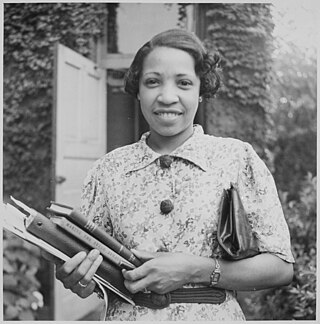
Lois Mailou Jones (1905–1998) was an artist and educator. Her work can be found in the collections of the Smithsonian American Art Museum, The Metropolitan Museum of Art, the National Museum of Women in the Arts, the Brooklyn Museum, the Museum of Fine Arts, Boston, Muscarelle Museum of Art, and The Phillips Collection. She is often associated with the Harlem Renaissance.

The Portland Art Museum (PAM) is an art museum in downtown Portland, Oregon, United States. The Portland Art Museum has 240,000 square feet, with more than 112,000 square feet of gallery space. The museum’s permanent collection has over 42,000 works of art. PAM features a center for Native American art, a center for Northwest art, a center for modern and contemporary art, permanent exhibitions of Asian art, and an outdoor public sculpture garden. The Northwest Film Center is also a component of Portland Art Museum.

Lola Álvarez Bravo was the first Mexican female photographer and a key figure in the post-revolution Mexican renaissance. Known for her high level of skill in composition, her works were seen by her peers as fine art. She was recognized in 1964 with the Premio José Clemente Orozco, by the State of Jalisco, for her contributions to photography and her efforts to preserve the culture of Mexico. Her works are included in the permanent collections of international museums, including the Museum of Modern Art in New York City.

The Museo de Arte Moderno (MAM) is a museum dedicated to modern Mexican art located in Chapultepec Park in Mexico City.
Wilhelmina Cole Holladay was an American art collector and patron. She was the co-founder of the National Museum of Women in the Arts, and was awarded the National Medal of Arts in 2006.
Marion M. Bass, known as Pinky Bass or Pinky/MM Bass, is an American photographer, known for her work in pinhole photography.

The Museum of Latin American Art (MOLAA) was founded by Dr. Robert Gumbiner in 1996 in Long Beach, California, United States, and serves the greater Los Angeles area. MOLAA is the only museum in the United States dedicated to modern and contemporary Latin American and Latino art.
Chakaia Booker is an American sculptor known for creating monumental, abstract works for both the gallery and outdoor public spaces. Booker’s works are contained in more than 40 public collections and have been exhibited across the United States, Europe, Africa, and Asia. Booker was included in the 2000 Whitney Biennial, received a Guggenheim Fellowship in 2005, and an American Academy of Arts and Letters Award for Art in 2001. Booker has lived and worked in New York City’s East Village since the early 1980s and maintains a production studio in Allentown, Pennsylvania.

The Museo Dolores Olmedo is an art museum in Xochimilco, Mexico City, based on the collection of the Mexican businesswoman Dolores Olmedo. The museum will be relocated to Chapultepec in 2024.

Les Trois Grâces is a set of three public artworks by French-American sculptor Niki de Saint Phalle. The Three Graces were a part of the National Museum of Women in the Arts New York Avenue Sculpture Project. It was created in 1999. It is located in Washington, DC, United States.

Nana on a Dolphin is a public artwork by French sculptor Niki de Saint Phalle. Nana on a Dolphin is part of the National Museum of Women in the Arts New York Avenue Sculpture Project and has also been on display at the home of Nicole Salinger in Provence, France.
Frida Baranek is a Brazilian sculptor known for creating large sculptural works that incorporate fibers and industrial materials such as plates, rods, and iron or steel wires as commentary on industrialization and the environment in Brazil.
The Clara database of women artists was a database named after Clara Peeters that was created and operated by the National Museum of Women in the Arts. It contained biographical information on 18,000 women visual artists of all time periods and nationalities. The information was drawn primarily from materials in NMWA's own archives, but various portraits used to document the entries were obtained from other libraries in the NMWA's network. The Clara database was maintained from 2008 to 2012 but is no longer being updated. It is accessible on the Wayback Machine. Some of the artist profiles from the database are now a featured component on the NMWA website.

The first international exhibition of art by female artists opened on December 21, 1976 at a time when the Feminist Art Movement was gaining in support and momentum. The show was curated by Professors Ann Sutherland Harris and Linda Nochlin and included eighty-three artists from twelve countries. The four-city exhibition was organized by the Los Angeles County Museum of Art and was on view there from December 21, 1976 through March 1977. The exhibition went on to show at the University Art Museum in Austin, Texas and then to the Carnegie Museum of Art in Pittsburgh, Pennsylvania, after which it completed its run at the Brooklyn Museum in New York. The Alcoa Foundation and the National Endowment for the Arts provided grants for the exhibition. The show became an important event in the history of art, introducing viewers, who were accustomed to a history of art dominated by men, to the important contributions of women artists. However, the show consisted almost entirely of white female artists. The show only included one artist of color, Frida Kahlo, and no black artists.
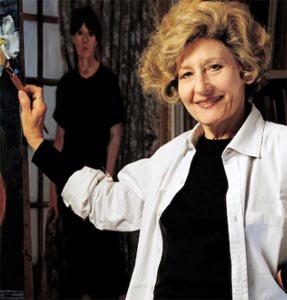
Clarice Smith was an American painter and portraitist whose paintings have appeared in a number of exhibitions in the United States and Europe. With her husband, Robert H. Smith, Clarice Smith engaged in philanthropy, especially at the University of Maryland, where the Clarice Smith Performing Arts Center is named for her, and at George Washington University, where the couple endowed the Smith Hall of Art. They also initiated a distinguished lecture series at the Smithsonian Museum of American Art.

Self-Portrait Dedicated to Leon Trotsky, also known as Between the Curtains, is a 1937 painting by Mexican artist Frida Kahlo, given to Leon Trotsky on his birthday and the 20th anniversary of the October Revolution. Kahlo and her husband, artist Diego Rivera, had convinced government officials to allow Trotsky and his second wife, Natalia Sedova, to live in exile in Mexico. The Russian couple moved into the Blue House (La Casa Azul), where they resided for two years.






